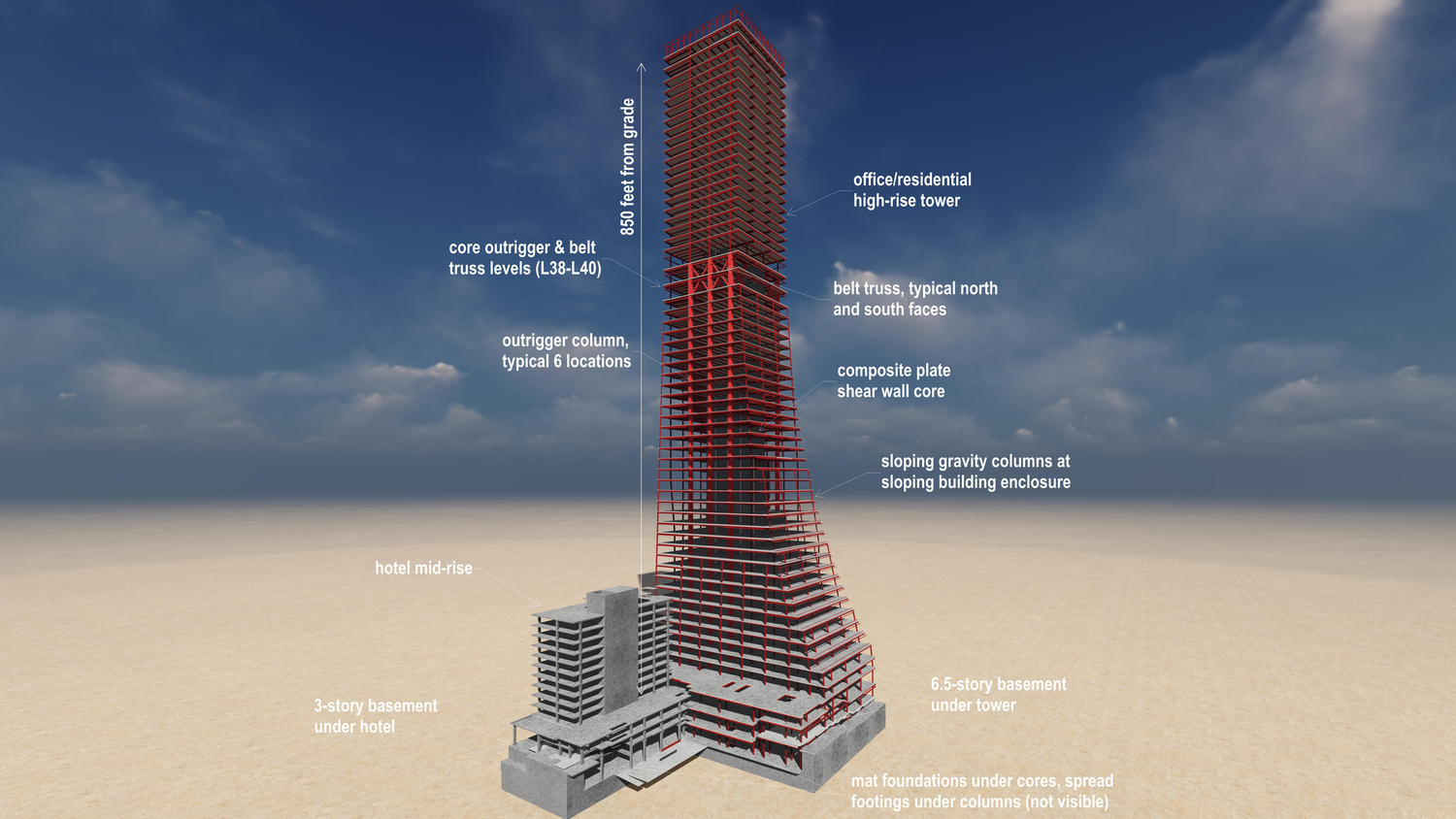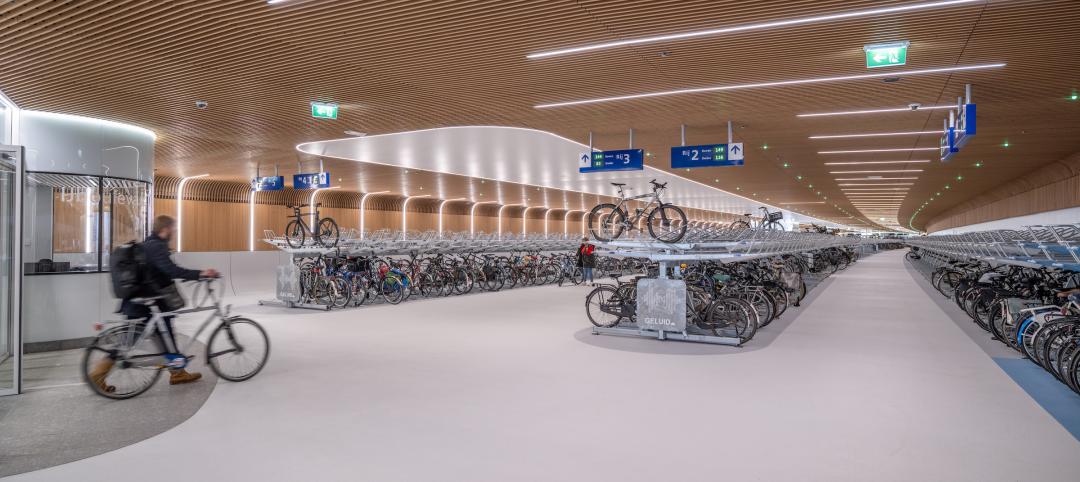Over the past 50 years, high-rise construction had gone through several approaches. In the 1960s, tall buildings were braced around their perimeters, but developers and tenants objected to obstructed views, which led to a shift toward steel cores. That method, however, proved uneconomical, and was replaced, in the 1980s, by structural systems with braces of large composite columns filled with concrete.
The diameters of those columns got in the way of elevators, bathrooms, and corridors, so in the 1990s cores were built with reinforced concrete, which are how most skyscrapers are constructed today.
But construction is still dictated by how fast the core gets built. Enter Speed Core, a steel-and-concrete composite core wall system that uses two steel plates connected by steel spacing ties with a cavity between the plates filled with high-strength concrete.
Magnusson Klemencic Associates (MKA), which spearheaded the development of this concept, is using Speed Core for Rainer Square, a 1.4 million-sf, 850-foot-tall, 58-story apartment and hotel building in Seattle.
 Source: Magnusson Klemencic Associates
Source: Magnusson Klemencic Associates
Through June, 40 stories were finished, and MKA expects construction to take 22 months, saving eight months from what it would have taken to build with a reinforced concrete core.
Ron Klemencic, PE, SE, Hon. AIA, Chairman and CEO, says his firm got the idea for Speed Core after it came across a technique developed in the United Kingdom that was used primarily for blast protection by the defense and nuclear industries.
MKA's R&D journey: A better way to build skyscrapers
In 2007, MKA engaged Purdue University, Klemencic’s alma mater, to research a new steel core system for high-rise buildings. The Charles Pankow Foundation funded the research.
It took three years to come up with a proof of concept for a composite sandwich panel, and another decade to find a client willing to try it on an actual construction project. Developer Wright Runstad & Company, a longtime MKA customer, allowed the firm to pursue this for Rainer Square. The team, which included architect NBBJ, spent six months on the design, which a panel assembled by the city of Seattle reviewed.
There are 240,000 rods used to connect the steel plates that are part of the panels. Purdue and the University of Buffalo are working on the next generation of core design, which Klemencic says might include smaller welds, thinner plates, and one-third fewer rods.
Klemencic says Speed Core aligns with MKA’s ambition to improve with every project. “With Speed Core, we’re living the dream,” he says.
MKA’s two-year-old foundation is funding research into performance-based wind engineering, reducing the carbon footprint in construction materials, and water resource management in buildings.
Related Stories
Design Innovation Report | Apr 19, 2023
Meet The Hithe: A demountable building for transient startups
The Hithe, near London, is designed to be demountable and reusable. The 2,153-sf building provides 12 units of business incubator workspace for startups.
3D Printing | Apr 11, 2023
University of Michigan’s DART Laboratory unveils Shell Wall—a concrete wall that’s lightweight and freeform 3D printed
The University of Michigan’s DART Laboratory has unveiled a new product called Shell Wall—which the organization describes as the first lightweight, freeform 3D printed and structurally reinforced concrete wall. The innovative product leverages DART Laboratory’s research and development on the use of 3D-printing technology to build structures that require less concrete.
Smart Buildings | Apr 7, 2023
Carnegie Mellon University's research on advanced building sensors provokes heated controversy
A research project to test next-generation building sensors at Carnegie Mellon University provoked intense debate over the privacy implications of widespread deployment of the devices in a new 90,000-sf building. The light-switch-size devices, capable of measuring 12 types of data including motion and sound, were mounted in more than 300 locations throughout the building.
Architects | Apr 6, 2023
New tool from Perkins&Will will make public health data more accessible to designers and architects
Called PRECEDE, the dashboard is an open-source tool developed by Perkins&Will that draws on federal data to identify and assess community health priorities within the U.S. by location. The firm was recently awarded a $30,000 ASID Foundation Grant to enhance the tool.
Cladding and Facade Systems | Apr 5, 2023
Façade innovation: University of Stuttgart tests a ‘saturated building skin’ for lessening heat islands
HydroSKIN is a façade made with textiles that stores rainwater and uses it later to cool hot building exteriors. The façade innovation consists of an external, multilayered 3D textile that acts as a water collector and evaporator.
Women in Design+Construction | Apr 5, 2023
Carole Wedge, former Shepley Bulfinch President and CEO, retires after 37 years
Wedge’s 37-year career at Shepley Bulfinch evolved a historic firm into a national design practice.
AEC Innovators | Mar 27, 2023
Leading architecture, engineering firm HED appoints new co-CEOs
As children of immigrant families, Van Herle and Suarez will bring a diverse perspective into a historically underrepresented industry and advance the firm’s mission of creating a positive impact for clients, communities, and the world.
Transportation & Parking Facilities | Mar 23, 2023
Amsterdam debuts underwater bicycle parking facility that can accommodate over 4,000 bikes
In February, Amsterdam saw the opening of a new underwater bicycle parking facility. Located in the heart of the city—next to Amsterdam Central Station and under the river IJ (Amsterdam’s waterfront)—the facility, dubbed IJboulevard, has parking spots for over 4,000 bicycles, freeing up space on the street.
Building Tech | Mar 14, 2023
Reaping the benefits of offsite construction, with ICC's Ryan Colker
Ryan Colker, VP of Innovation at the International Code Council, discusses how municipal regulations and inspections are keeping up with the expansion of off-site manufacturing for commercial construction. Colker speaks with BD+C's John Caulfield.
AEC Innovators | Mar 3, 2023
Meet BD+C's 2023 AEC Innovators
More than ever, AEC firms and their suppliers are wedding innovation with corporate responsibility. How they are addressing climate change usually gets the headlines. But as the following articles in our AEC Innovators package chronicle, companies are attempting to make an impact as well on the integrity of their supply chains, the reduction of construction waste, and answering calls for more affordable housing and homeless shelters. As often as not, these companies are partnering with municipalities and nonprofit interest groups to help guide their production.

















